No Matter The Implementation, Light Rail Doesn’t Spur Development
A number of years ago the East-West Gateway Council of Governments, the MPO (Metropolitan Planning Organization) for the St. Louis region looked at options to get light rail transit to north county and south county, see MetroLink Northside-Southside Study. The final report on October 10, 2008 recommended future routes to North County and South County that included using part of existing roadway. I wasn’t convinced.
Last week I posted about things I liked about DART (Dallas Area Rapid Transit) but today I’m going to use DART to talk why I’m cautious about expanding out own light rail system, MetroLink. Light rail as a mode of transit moves people well, but it doesn’t automatically spur development the way a streetcar can and costs far for than a bus line.
Just before I left for my trip to Texas and Oklahoma I received the following publication at a transit-oriented development event here in St. Louis.
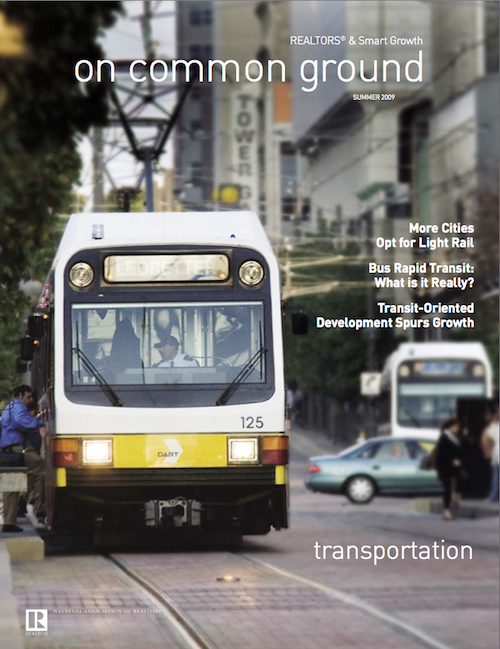
Looked exciting, I couldn’t wait to see and experience it. Let’s take a look at the reality of light rail in Dallas.
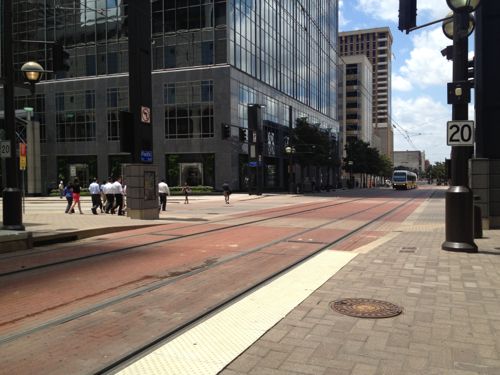
In downtown Dallas numerous light rail lines converge on Pacific Street, now closed to traffic, with exceptions in a few limited spots. It’s a pretty lifeless street other than people going to/from the light rail stations. Pedestrian traffic is less than other nearby streets. No sidewalk cafes, not much of anything other than a couple of stations. This is what you get when you give a roadway such a single, and limited, purpose.
On the plus side their light rail is highly visible, whereas our MetroLink is nearly invisible in downtown St. Louis since it runs under Washington Ave and under 8th Street. The planned northside-southside lines in St. Louis would go through downtown at grade and be visible.
DART’s blue Line South
n
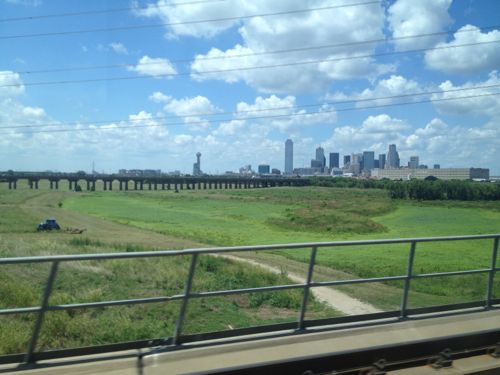
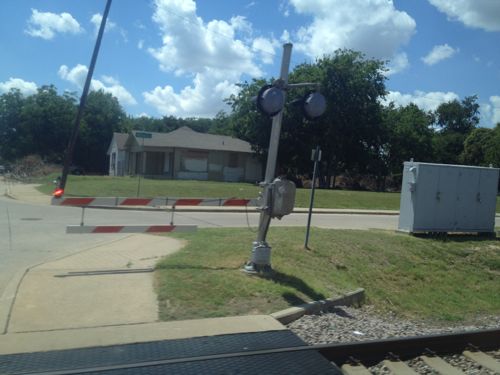
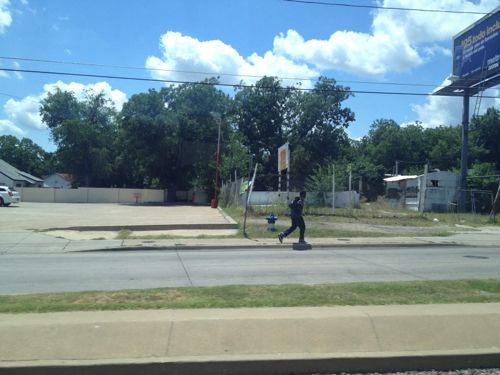
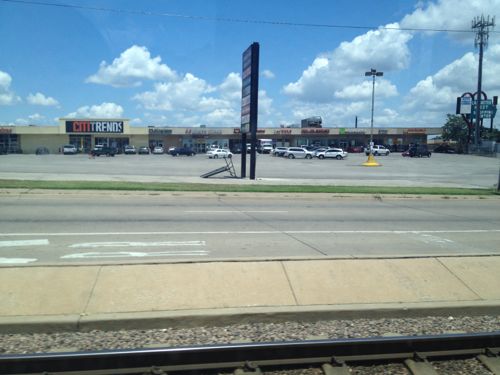
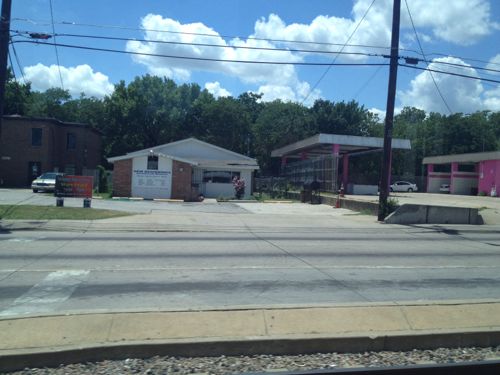
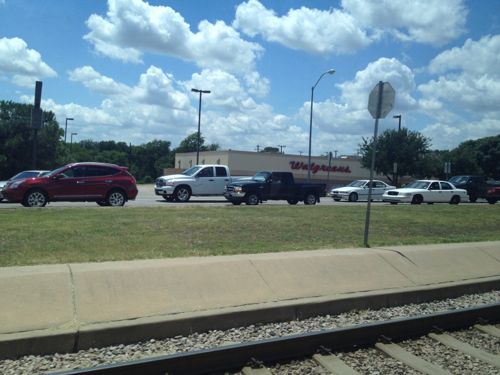
Blue Line North
b

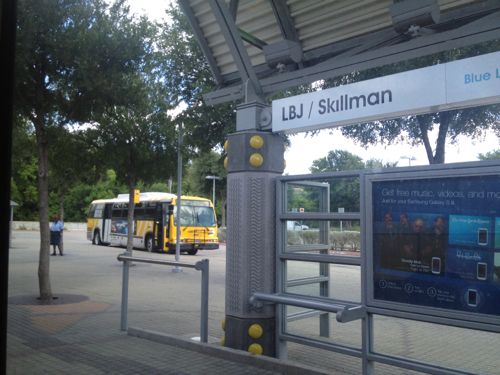
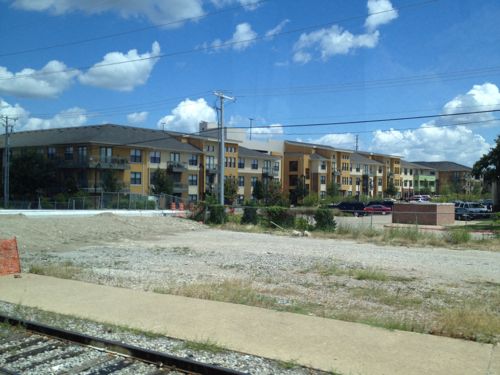
I’ve got hundreds more images from DART’s Blue & Red lines but you get the idea. Relatives and friends in Dallas said they don’t use the light rail because it’s too inconvenient to use, having to drive to the station and park. They’d just as soon drive to their destination.
Light rail, by design, is separated from its surroundings. It’s below grade, elevated above grade, squeezed in the middle of a busy roadway, etc.. But it’s not connected to the street grid in the way a streetcar or even a bus is. Thus, many have to drive to reach a station.
Both the streetcar and bus are right outside the door and both make frequent stops so you don’t have massive areas without service, like you do with light rail. That said, I can’t imagine taking a bus to the airport. Conversely, when I go to the Delmar Loop I take the #97 (Delmar) MetroBus because it’s far more convenient.
Back to the northside and southside MetroLink expansion. I’d support rail transit but only in streetcar or BRT form. Light rail costs more to build and as we’ve seen in St. Louis it hasn’t produced measurable development.
St. Louis was developed largely with help from streetcars, horse drawn initially. I expect, no I demand, development to be a result of investment in transit infrastructure.
— Steve Patterson
This shows the difficulties of designing light rail in existing developed areas. It looks like is was done poorly on DART with few connections between rail, roads, and the existing development. The line itself doesn’t spur development, but the stations could. Otherwise the nusiance effect of the train outweights the accessibility effects. It appears that too many of the stations are separate from the existing neighborhoods. That is the problem with park-and-ride lots, they take out too much land that could be used for development around the station, and they separate the station from the existing neighborhood. If you are driving to the station, why not drive the whole way?
I totally disagree with you on this one, Steve. I’m not going to argue whether transit investments spur development or not, but rather that light rail is necessarily disconnected (and therefore has inferior development potential). Look at Trimet for the perfect example of how convenient and connected light rail can be. Look at Pioneer Square in Portland – walk around the square via streetview – and see how seamlessly the light rail interacts with cars and pedestrians. MAX serves as a “commuter train” out to the suburbs and downtown it serves more as an urban circulator. It’s certainly connected into the fabric of the surrounding neighborhoods and more importantly, the rest of the transit system is high-frequency, there are wide, comfortable sidewalks, and driving and parking are a lot more inconvenient than they are in St. Louis, all of which supports people walking (and busing, and bicycling) to connect with MAX rather than driving – especially at the more urban stations but even at the suburban stations, in my experience.
Portland is often cited for a number of planning issues done well, it’s more the exception rather than the rule. Remember that Oregon has had statewide land use planning for nearly 40 years now and the Portland region has an urban growth boundary! Portland had a transit mall in place since 1977, the light rail was added later and buses run in the same space as the rail. Portland also has only one track per street so as not to kill the street as in Dallas. Again, Portland is the exception.
One thing that Trimet does well is adapting the light rail to the environment. In the suburban/exurban areas it operates more like a commuter rail system with higher speeds, few stations, and dedicated right of way. In the downtown area, it operates in the street at slow speeds with good connections to streetcar, bus, and streets.
Any redevelopment created by new transportation infrastructure will be very gradual in St. Louis so it is more important how it fits into the existing built environment.
I think Max is reaching limitations for all and intents and purposes. Just drive across the river into Vancouver and you wonder why the result for a expansion into Washington side of the river wouldn’t be any different than what Steve shows for a good part DART. Max success has a lot to do with land use decisions along with geographical limitations that minimize developable area, minimizes freeway access (St. Louis has I-55, I-44. I-64, and I-70 converging where as Portland has I-5 and I-84) promote density and therefore made light rail/fixed a viable transportation option and why it made sense to offer more.
That being said, I would love Metro to extend the current metrolink lines a few more stations on the Missouri side (Extend past airport to Earth City & go to I-55 ) and add the second line to SIUE on the Illinois. Beyond that Metrolink will have essentially tied the major institutions/universities (besides Lidenwood), airport, largest medical complex/medical school, the two business districts (about as dense employment centers as your going to get for the area), sporting venues, etc. Essentially, metrolink has accomplished what that make sense light rail.
Which gets me back to Steve’s comments and what I would certainly agree with. I would be very cautious about expanding light rail in St. Louis much beyond the current system. I would certainly think a full blown N-S line let alone the Daniel Boone extension would tie up resources for years to come that could be much better spent on incremental improvements to the system. Investments in selected street car lines in the city (N-S as a streetcar, Grand, Dowtown to CWE), express bus services (you don’t need to build out BRT when the area freeways have capacity) and other incremental improvements to the bus service (free and expanded downtown trolley) make much more sense to me.
The real problem that the region is facing, especially on the Missouri side, is that we’re trying to figure out how to fit better public transit into existing areas instead of integrating rail transit into the growing fringe areas. Even if most residents of St. Charles and Jefferson counties don’t see a need for transit, the simple fact that many new jobs are being created out there should argue for pushing transit out to those employment centers. If/when the only transportation investments being made are on the highway side, you perpetuate the mindset that transit is just not necessary, which, in turn, chokes off funding.
Both DART and RTD (Denver) push light rail out to the fringe, much like how Metro does in Illinois, here. Development on the fringe is going to happen with or without rail transit. Having transit in place before development starts means that it can be integrated as development proceeds. In Missouri, with rail transit ending at a fading airport and an isolated south city park-and-ride lot, any development incentives have been essentially squandered by poor corridor decisions. Combine that with poor connections between the Red and Blue lines and you perpetuate the perception (and the reality) that using transit takes way longer than just driving . . . .
While transportation investments should spur development as you say, that should not be their only and not even the most important purpose of such investments. The most important aspect of transportation investment should be increased mobility, something that streetcars that are in traffic most certainly does not provide. Light rail delivers much better mobility improvements and with cities that lack the funds for rapid transit, are the fastest form of public transportation. Streetcars that lack dedicated lanes are expensive and offer few mobility improvements for transit riders. I would not be opposed to streetcars with their own right of way such as these: http://lewisnvillegas.files.wordpress.com/2011/07/toronto-queenstreet-empty.gif, however in general mixed traffic transit simply guarantees that transit will be stuck in congestion.
St. Louis doesn’t have congestion. The proposed light rail additions for St. Louis offer too few stations to be useful for residents except the lucky few that live & work near stations.
But by creating those stations, you’re at least laying the groundwork for places where people can choose to live/work near stations — rather than planning a bus trip that is inconsistent (note: I take buses regularly — it isn’t for the hurried!) or relying on a car. And you’re right – St. Louis isn’t congested, so why does so much money go toward expanding the highway system (Answer: there’s not enough buy-in for public transit).
I think part of the problem is a catch 22….if you build/use Metro you do not stop enough to make side investments worth while unless it is around the stops (and our Metro tracks, built on the old rail right-of-ways are not conducive to the neighborhoods it cuts through…..If you stop more often to spur that investment, then the Metro moves to slow and people will use their cars. And this is also true of the busses as well.
PeterXCV touched upon it — new development is all well and good, but the main function of light-rail transportation is to, obviously, transport people. That’s why a N-S line — or at least a Southside line for starters — is so important: it’s allowing one of the City’s densest, most intact areas the choice of accessible rail transit to the city center and points around. More importantly, it’s allowing another choice for public transportation.
I have my own opinions on which of Metro’s proposed lines makes more sense (the De Soto ROW vs. a line parallel to I-55), but there is no area of St. Louis for which lightrail can offer an immediately positive ridership increase than the many neighborhoods south of 40. Development is nice, but creating access to riders is most important.
People currently have access to public transit to downtown, numerous bus lines connect the dense neighborhoods south of downtown to the core. It is clean, safe and reliable. If we spend hundreds of millions on light rail then I expect more than simply moving people from point to point in a different mode than currently available.
You’ve talked about the psychology of public transportation many times before, Steve — mainly how streetcars and train lines are more quickly and confidently embraced by the public because they are seen as secure — that they can be counted on. A rail line can’t be easily removed because of a budget shortfall and it can’t be re-positioned or realigned on a whim either. People can use it and be comfortable in knowing that.
First comes the buy-in to public transportation, and yes, I’m talking about it as an amenity, not as a necessity. The people you most need to embrace public transportation are the middle (and upper-middle) class who can afford to have a car and drive it where they need to go. The bus lines serve their purpose and people on the south side DO utilize it, but you need a south rail line otherwise there’s no way of combating sprawl and car culture. You won’t convince the person working as a clerk at Macy’s or as an operator at a downtown law firm to take that bus with any sort of regularity (without heavily-increased service anyway) — but you can get them to buy-in to Metrolink. And from there, it’s a person-by-person discovery of the other ways that they can connect and get around via the bus system.
Yes, the hope is that any new stations on a southside line would at the very least be welcoming to riders, both visually and functionally, and that that sense of place would encourage businesses to invest nearby. But there is no Transit-Oriented Development without Transit-Oriented Buy-In.
I moved to St. Louis two years ago from Washington D.C. where I lived my whole life. When they started building the new Silver Line a few years back, dense residential and commercial development started happening next to the planned stations before the actual rail construction even started. It seems to me that developers around in St. Louis (or Dallas, for that matter) are simply clueless to the idea that building dense residential and/or commercial next to a MetroLink station would be desirable. The current construction of an ultra-low density car dealership directly next to the Sunnen station is a perfect example.
I think you are right, there is a cultural difference in the Midwest, with individuals as well as developers, that aren’t accustomed to high-density. Also, demand for housing is much higher in the DC area (and jobs are probably more concentrated) so high density near rail makes more sense there.
I think it is far from cultural difference and more a demand for transportation infrastructure and demand because their is a growing population, job base (in large part to an expanding federal gov’t) and limited amount of developable space. The beltway is packed and jobs are located in some very specific dense areas/corridors. It is simply easier, quicker, and in some respects cost effective to use a car in St. Louis vs DC, New York City and so on. You simply don’t have that in St. Louis nor should anyone expect that anytime soon.
One, by definition, transit-oriented development ONLY happens around stops, not along the in-between parts. Two, most transit properties design and operate both light rail and/or heavy rail, to move large numbers of people over greater distances, leaving buses and, occasionally, streetcars, to provide the finer-grained service of moving fewer people over shorter distances. Three, putting one and two together, you get a mixed answer – most individual light rail stops generally attract more riders than most individual bus stops, but you get no guarantees that any stop will be viewed as either a positive or negative when it comes to supporting investment, development and/or redevelopment.
One of the problems facing Metro is that our light rail system, especially the Blue line, is designed to meet political realities and demands more than it is designed to make logical transit connections. Good public transit is very much a chicken-or-egg proposition – it takes more riders to justify more service, and it takes more service to attract more riders. Until we create a clear hierarchy of the services each vehicle type provides, we’re going to struggle with justifying “better” development at any of our stations.
The central corridor is the ‘power’ corridor, the corridor that is served. They dont care about north or south city or county and never did. Studies done here are to try to justify failure.
1. Buses and/or streetcars work all right within St Louis City. For longer distances they are too slow to be practical. For example Wellston-Downtown takes 15 minutes by MetroLink and 40 minutes by bus (route 94). Adding 50 minutes to your daily commute is roughly a 10% tax on your work time (8 hours=480 minutes). Building light rail to the suburbs has the same effect as lowering taxes by 10% for thousands of people indefinitely. Sure, this doesn’t help make St Louis City prettier. But for those of us who care about people more than bricks, and who care about the 89% of the region’s population living outside the city, it’s a real benefit.
2. Light rail DOES promote development. Here are pictures from the St Louis area.
https://maps.google.com/?ll=38.648484,-90.327015&spn=0.022557,0.045362&t=m&z=15&layer=c&cbll=38.648495,-90.327143&panoid=9fui-j2lH8OKTDDamkceQg&cbp=12,172.16,,0,-7.48
https://maps.google.com/?ll=38.634847,-90.34511&spn=0.022695,0.045362&t=m&z=15&layer=c&cbll=38.634847,-90.34511&panoid=_zFKU7oIrNqWgtKqm1c2Yw&cbp=12,0,,0,0
https://maps.google.com/?ll=38.637858,-90.345511&spn=0.022694,0.045362&t=m&z=15&layer=c&cbll=38.63805,-90.344994&panoid=8n-R8iRLPCovO0evkP2EJg&cbp=12,117.84,,0,-1.79
3. Dallas is well known as the least successful major light rail system in North America. You would be fairer if you also looked at one of the more successful ones. For example, Houston’s system has 5 times as many riders per mile as Dallas’.
I agree the the extension of light rail should be limited at this
juncture. But more because I feel the leadership of this community
should get the City of St. Louis transit fixed first. St. Louis was
designed as a transit friendly city, if they cannot get St. Louis right,
they cannot possibly succeed regionally.
Making transit work with city planning has to a central feature of city building. While there is no doubt streetcars probably offer more opportunities for development than light rail due to its nature, if the the will to make any transit, including bicycles or walking successful then transit is unlikely to spur development or more importantly properly serve the citizens.
Daniel Layton points out how a low density car dealership is being built in the county next to Sunnen station. It is the same problem with the Grand Ave station. Why isn’t there a transit zone in the zoning codes, demanding density and walk ability? Why should the public invest in light rail if the city and regional plan does not support it?
What continually blows my mind is the totally inept response in the face
of global warming and oil and energy shortages. If city and regional leaders can’t get the
job done they should resign en mass and let others take care of
business.
They can’t even change zoning in an attempt to support transit, come on, just how helpless are the people that set policy?
Zoning typically places limitations on allowable uses and establishes maximum densities. Rarely does zoning set a “floor” or minimum density to be constructed, for the simple reason that economics dictates whether anything and what gets built. Government and citizens may want more density, but the property owner likely can’t afford to build as dense as we want them to. The choice then becomes something versus nothing, not something versus something better. For better or worse, private property rights are a given in our lives, and will continue to drive future development patterns.
Wrong, the simple reason most zoning has it backwards is it was created in the mid 20th century when planners felt the need to destroy urbanity to give the car more room.
What part of what I stated is “wrong”? Current zoning sets maximum lot coverage, limits and segregates uses and does not set minimum densities (in most cases). While the concept may be “wrong”, the reality is what it is! You can’t, in most cases, force a private property owner to build MORE than they choose to or can afford to build!
Zoning enacted in the last five years completely rejects the typical” zoning that puts the individual over the community. Ayn Rand is dead and hopefully so will use-based zoning.
. . . and where around here do we see any form-based zoning?! Getting back to GMichaud’s assertion that the city needs to do a better job of planning for transit, I agree. But before we can even talk about implementing form-based zoning, we need to reach a consensus about what our planning vision and goals are or may be. We can’t just go in and do a one-for-one swap of form-based zoning fo euclidian zoning. Your vision may be St Louis city switching entirely to something that would replicate Soulard or the CWE, but yours is only one voice and one vote. Our government is a democracy, not a dictatorship, even if you really do know what’s best for the rest of us . . .
And the only place that there is a discussion of these issues is here, at Urban Review. Despite the seriousness of the many concerns (livable cities, global warming, oil shortages), democratic discussion does not occur in the main stream media nor within government itself. The disposition of transit and the relationship to city planning is in my mind the key discussion that is missing, except here with Steve.
Either Steve should be the Mayor, or the Mayor and Board of Aldermen should get off their ass. How are visions and goals to be attained? Some back room “expert” telling us what to think?
Without democratic discussion of the issues nothing is possible.
St. Louis should be a show place city in the nation.
I agree, partially. Discussion certainly does not appear to be happening locally, either in the mainstream media or, with a few exceptions, in local government. This was quite a surprise to me, coming from Denver, where I’d been involved in multiple positive planning and zoning initiatives.
The real question is why is this our reality? Do most people here simply not care? Are we so narrowly focused, on our own ward, parish or suburban “city” that we can’t be bothered by what’s happening 2 miles away? Do we lack the financial resources that it would take to update our city plan and zoning? Are our political leaders so disconnected that they either can’t be bothered or just don’t see the need? Is the lack of demand skewing the process so badly that we jump at any “development”, no matter how “bad” it might be? All of the above?
My experience in Denver is that it takes a combination of motivated neighborhood leaders, engaged political leaders, professionals willing to share their expertise, developers wanting to do projects and the right economic conditions. Change rarely happens unless there’re incentives and/or the ability to apply pressure to “motivate” better design choices.
You are right, it takes a whole host of people to make change happen. Although I not sure it is necessary to apply pressure to “motivate” better design choices. Actually I don’t think it would take even a masterful design would be needed to get people excited in St. Louis. If a design proposal looked like it made sense, it would probably gather support.
The reason I think people don’t care is our educational system. Few citizens are exposed to architecture and urban planning in their schooling, including those who go to college. At most people take an art history class or something similar. There is a lack of in depth discussions about the environment we live in every day. It is a real irony that something so important to our lives is largely ignored.
Ignored? You mean like sex education? personal finance? phyical fitness? American history? American constitution? Sad indeed.
I was just pointing out that even the most remedial attempts at trying to make transit successful are not carried out. Zoning, something all of the characters in the one act play of government know about, isn’t even attempted.
I also disagree with the notion that private property rights take precedent over public good. St. Louis has tried that method for 60 years without success. We are left with the urban mess of today.
Just as you would not like it if I bought up and tore down all of the homes surrounding you and built a hog slaughtering facility, it is also in the public interest to have a successful transit system, and it is in the public interest to protect the considerable investment in light rail.
Developers deal with restrictions all the time.
Ultimately the stance of government, which is no stance at all, hurts development. If a city is committed to plans to build up a transit system through city planning, I believe you would have developer buy in.
In the case of the building of the suburbs of Vallingby and Farsta outside Stockholm, Sweden (David Pass MIT press). Plans were developed and negotiations occurred with potential commercial partners and the Stockholm City government in real time.
The integration of transit was a major factor in the negotiations.
In St. Louis the planning solution seems to be “Whatever”, a favorite stance of advocates of private property rights.
Ultimately it is only government, not individual developers, that are capable of connecting the many diverse aspects of the urban environment into a city all can enjoy and live in. Private enterprise cannot perform that task.
Some interesting comments for sure. But for all the talk of zoning, design, placement, etc, where is the talk about cost? One of the biggest, if not the biggest issue are the costs. There was a recent article in the Wall Street Journal (wednesday I think it was) citing new light rail in a number of cities. HUNDREDS of millions of dollars to go 2, 3 and 4 miles. Most of them federal tax dollars. It’s like they should be made of gold!!!
I am no nut job ultra conservative by any means, and think that certain transportation costs should be bourne by the federal tax payers. I realize that it is rare for any transport line to reach the break-even point, and rarer still for any to make a profit. But just because there is no hope of ever making a profit or that the transport agency is a non-profit does not give them carte blanche to be non-cost containing.
Today’s projects are financed with the majority of dollars being federal, then a mix of state and local. I believe that it should be the other way around. States and locals must pick up the greater share of the costs and be more responsible in getting bang for the buck.
But no matter the funding mix, the costs need to drop and drop drastically.
That’s part of what I was getting at, the technology requires its own right of way so you often end up with expensive elevated structures or more expensive tunnels. I wouldn’t object to the cost if there was a greater return on the investment in the infrastructure.
Given the popularity of light rail, over the past couple of decades the local match requirement has gone up while the federal percentage has dropped from something like 90% to something closer to 65%-70%. As I understand it, Metro’s first segment here was almost entirely funded with federal dollars, since the value of the right-of-way, including the tunnels downtown, was considered to be the local match.
In a good transit system, every technology potentially has a place. What we need to focus on is defining the problem, then selecting the appropriate technology, not the other way around (selecting a technology, like light rail, then seeing where we can “fit” it into the region). Small buses, regular buses, articulated buses, double-decker buses, transit coaches, individual streetcars, articulated streetcars, linked street cars, light rail, heavy rail, DMU’s, cable cars, passenger ferries and van pools can each provide the “right” answer for a given situation. It’s not all or nothing, it’s more about providing frequent service, quick and easy transfers and a system perceived to be, at worst, just OK (and hopefully much better than just OK).
Cute quirky or different can get people out of their cars once or a few times, but it won’t, alone, get them to switch to transit. Quirky and different can also easily describe the transport system to the top of the arch or the roller coaster at Six Flags. Regular transit users and the consumers of TOD are less concerned about whether they’re on a bus or a train and much more concerned with how long it takes to get from Point A to Point B. In cities where TOD is happening (Portland, Denver, DC or LA), the key component is that a significant number of the non-transit-dependent are CHOOSING (or are being forced to) to both use transit on a daily basis and to embrace significantly higher densities (no more 1- or 2-story buildings within a quarter mile of any station).
I like to remember that money is imagination. It is only real because we make it real. One of the tenants of architectural and urban design is that you find the solution first, then work with money to finalize concepts and ideas.
A few things can happen.
A great urban plan is presented that the public loves and as a result the public wants to find the money to support it.
Or, the project is modified, and the then an attempt is made to maintain the essence of the design.
Or, as if often the case, a phased project is used to meet the demands of finance.
Of the three the phasing of the project is a probable solution.
The real problem is the there is a lack of comprehensive designs that integrate all transportation (including autos) with city and regional plans. (The default non-plan is the automobile determines all patterns).
Money isn’t the problem in my view. Government officials cannot even formulate a remedial zoning designation around light rail stations. It costs almost nothing to define characteristics of what a special zoning district for transit might look like to support those same light rail stations.
In other words being smart about your investment in light rail. Money, considerable amounts, have already spent on the light rail (and transit) system.
Would someone enlighten me on the use of monorails? I’ve wondered for a long time why it is so unpopular except for certain venues like Disneyland. It seems to me it would be less expensive to build platforms over existing highways as stations with escalators for access and the monorail placed in the center of the highway (or street). No “right of way” issues! Limited construction costs! Expanding the lightrail/monorail through out the city either as “feeder” lines to lightrail or in place of lightrail totally. It would be visible and convenient as well as fun speeding OVER the backed up highways.
Monorails do potentially address some ROW issues. Their challenges, however, are many. The first is that a single rail must necessarily be substantially larger (to address twisting) than two smaller rails, combined with the reality that a monorail vehicle needs wheels on three sides of its one rail, while a traditional train only needs wheels that are primarily only on one side of each rail (with a secondary flange on one side to keep each wheel pair on the track). The second challenge is gravity – it’s harder (and more expensive) to keep anything suspended than it is to have it on the ground – it doesn’t matter how many tracks are involved. The third is more political – most people don’t want to look at trains whizzing by their homes or businesses, and monorails do just that, no different than any other type of elevated train (see the buried section of Metrolink in Clayton). The fourth is that escalators aren’t good enough – the ADA requires access for people with disabilities, and elevators (yes, at least two) are the best solution for any station that is not at or close to grade. The fifth, and biggest reason, is financial – traditional rail is cheaper to build and operate than a monorail. Whether this differential could be narrowed through greater use is open to debate. These numbers are a bit old, but the relative differential should be pretty consistent: http://www.lightrailnow.org/myths/m_monorail001.htm